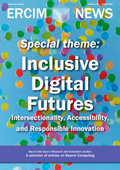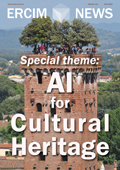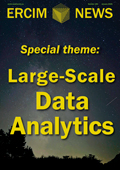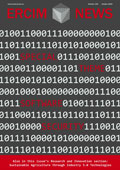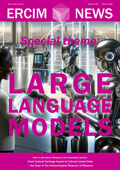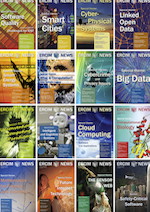Guest Editors: Magdalini Chatzaki (FORTH-ICS) and Anna Szlávi (Johannes Kepler University)
As Computer Science (CS) drives the digitalisation of nearly every aspect of modern life, it is vital that it reflects the diversity and variability of the real world in order to develop systems that address a wide range of societal needs. Digital technologies and artefacts influence all domains of life: they transform the world we live in, including society, the economy, and culture. Technological development and systems design are intrinsically intertwined with social progress and change. They are, in fact, the flagships of our societies.
But who designs and builds these digital systems, and for whom? Whose values do they embody, and whose interests do they serve? There is an urgent need to critically examine whether the digital space is being realised with inclusivity, diversity, equity, and participation in mind.
In this issue of ERCIM News, we explore how Computer Science can actively promote inclusion and diversity, both in the digital sphere and within its own working ecosystems and human capital. We have welcomed contributions from diverse fields of research and innovation, as well as reports on applied initiatives and policies.
Recognising the growing need to embed inclusion and diversity principles as both values and practices within CS education, research, and innovation ecosystems, this issue features articles spanning a wide range of topics, all sharing a common denominator: their contribution to inclusivity and diversity in the development of digital technologies.
To present the contributions, we grouped them into the following thematic categories:
Inclusive Digital Futures – Intersections of Technology, Security, Discrimination, and Bias
Contributions in this section address the intersections of technology and security, the risks of discrimination and bias that emerge in digital systems, and strategies to overcome these challenges toward more inclusive and safer digital futures.
Hatzivasilis et al. present the EU-funded SecOPERA project, which delivers a holistic framework for securing open-source software and hardware, reinforcing trust and sustainability. While open-source solutions empower innovation and accessibility worldwide, their security challenges can hinder responsible and inclusive digital development.
Kokolaki et al. raise important ethical and accessibility concerns regarding children’s access to online services, particularly the use of AI-based age estimation techniques. Their contribution, Promoting Safer Digital Environments, poses critical questions: “Do these practices truly serve the best interests of children, or do they risk reinforcing surveillance, bias, and digital exclusion?”
Christodoulaki et al. introduce SafeLine.gr, the Greek hotline against illegal internet content, officially recognised as the first Trusted Flagger at the national level in Greece under the European Digital Services Act.
Posnard et al. provide a historical perspective on how major biases have emerged in computing, how they are currently being addressed, and which barriers remain. Their key message is that technology itself is not the root problem; rather, underlying social, economic, and policy inequities must be tackled through education, entrepreneurship support, and inclusive digital policies.
Education & Training, Interventions, Policies, Protocols, and Tools
This set of contributions highlights educational and training initiatives, as well as policies and interventions, that aim to reduce gender imbalances in STEM and, in particular, in Computer Science. Several articles also introduce digital tools and approaches for more inclusive educational processes.
Szlávi et al. describe tools and resources developed to establish mentorship programmes that foster gender inclusion in Computer Science and STEM more broadly. Their work is part of the Erasmus+ Women STEM-UP project, which tackles persistent gender gaps in STEM.
Bytyçi presents pioneering efforts led by the Ministry of Education, Science, Technology and Innovation of Kosovo, together with the Austrian-funded HEI25 project, to better link research and teaching in public universities. At the University of Prishtina, Computer Science students turned coursework into hands-on research, simultaneously gaining practical skills and promoting gender balance in academia.
Patias et al. introduce SURE-VFT, a project that provides Surveying Engineering students with practical skills in photogrammetry, 3D modelling, and remote sensing through virtual field trips available via the XR4ED education platform.
Chatzaki et al. present MindGenGapICT, a 12-month institutional change project at FORTH-ICS that promotes diversity, inclusion, and equity within the institute. Addressing the persistent under-representation of women and marginalised groups in Computer Science, the project aims to deliver a targeted roadmap to leadership, including evidence-based recommendations, adaptation strategies, and follow-up plans.
Buzzi et al. explore how AI can enhance data literacy and inclusion by using storytelling techniques that increase accessibility for blind and visually impaired students, as well as adaptive platforms that support teachers in personalizing educational strategies, paving the way for an inclusive data literacy ecosystem.
Molin et al. discuss the approach adopted by the AIT Austrian Institute of Technology to rapidly integrate emerging AI technologies into both research and administrative processes, recognising AI as a key driver of competitiveness and innovation.
Altın et al. present the Breaking Boundaries in K-12 Classrooms (BBC) Erasmus+ project, which tackles gender inequality in STEM by equipping teachers, school managers, and pre-service educators with practical strategies for creating inclusive learning environments.
Ambient Intelligence & IoT, HCI, and Digital Accessibility
Szentirmai contributes two critical studies on Augmented Reality (AR). Rather than dismissing AR’s potential for inclusion and accessibility, these works question the balance between democratising skills and optimising usability for all. They highlight a paradox: using AR to enhance accessibility can sometimes undermine other essential values or even amplify situational disabilities under certain conditions. Both studies invite a rethinking of inclusive design principles, advocating for approaches that not only remove barriers but also preserve cultural values and ensure that accessibility coexists with other usability factors.
Dechambre et al. discuss how digital accessibility serves as a pathway to inclusion. When overlooked, millions of people with disabilities, along with those who are digitally marginalised, such as older adults or individuals with limited digital skills, are excluded. Promoting accessibility within organisations, institutions, and companies means fostering inclusion for all.
Peer et al. present a smart office system that uses a flexible, cloud-based IoT framework to adapt lighting, acoustics, and temperature in real time to different generational preferences, while providing facility managers with unified oversight. By localising environmental adjustments, the system maximises efficiency and enhances user comfort and productivity across age groups.
Margetis et al. offer an insightful state-of-the-art review on Design for All and Universal Access by pioneering researchers from the HCI Lab at FORTH-ICS. They address emerging challenges in an era of global transitions to AI-enabled environments, emphasising the need for new methodologies and tools to ensure technology remains accessible to all.
Big Data
The contributions in this section explore how social bias is transferred into digital systems, particularly within large language models (LLMs) and big datasets, and the challenges of detecting and mitigating embedded bias.
Sosto et al. confirm that social bias from the physical world is often reinforced in the digital domain. Their research contributes to developing more inclusive language technologies by critically examining and addressing model biases, promoting fairness, representation, and responsible AI practices — particularly for marginalised or misrepresented communities.
Sassatelli et al. introduce an ambitious and innovative idea: developing AI and deep learning models capable of detecting objectification bias in multimedia content. Their work within the TRACTIVE project exemplifies interdisciplinary collaboration between social scientists and technologists to address the complex and subjective issue of character objectification in films.
Conclusion
Together, these contributions highlight that research grounded in inclusivity and diversity principles is both active and essential. Covering a wide range of areas, from HCI and accessibility to bias detection in LLMs and datasets, responsible innovation, digital system security, education and training tools, and gender-balance interventions, this issue demonstrates that significant progress has already been made. Yet, it also underscores that much work remains to be done to build truly inclusive digital spaces.
Please contact:
Magdalini Chatzaki, FORTH-ICS, Greece
Anna Szlávi, Johannes Kepler University, Austria

